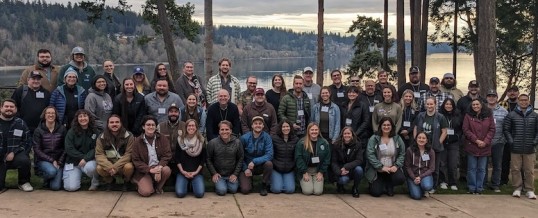
February 13, 2025
In this post, we’ll continue our reflections back on 2024 through the lens of the status and trends of European green crabs in Washington. In the last post, we shared observations from trapping efforts across Salish Sea shorelines. Here we shift to shorelines on Washington’s Pacific coast.
The Coast in Context
As of writing this post, the total number of individual green crabs removed from Washington shorelines in 2024 stands at 1,059,117 (WDFW Data Hub), more than twice the total of 2023. Of those, more than 1,054,500 (99.6% of the total) were captured in coastal estuaries, particularly Willapa Bay and Grays Harbor. The entireties of these large shallow estuaries are ideal habitat for this species and their greater proximity to larger sources of green crabs from outside of Washington have caused populations there to grow rapidly.
Thankfully populations of green crabs aren’t the only thing growing in coastal estuaries. Trappers literally doubled down in 2024, setting at least twice as many traps as the previous year to help remove as many green crabs as possible. Yet even accounting for increased effort, we estimate that catch rates, which are a loose proxy for overall crab population abundance, were three to five times greater in 2024 compared to 2023.
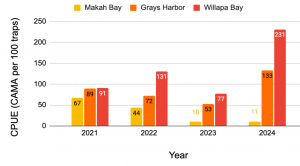
Annual catch rate of green crab for coastal Crab Team monitoring sites averaged across coastal region since 2021.
One very important factor in the big jump this year was related to last year’s El Niño conditions. The warmer winter waters allow for greater survival, and more rapid development, of any larvae in the water, resulting in an influx of juveniles. These larvae could be locally released and stay within their estuaries through the 20-40 day long development, or they might come from other sites, or a combination of both. It’s not always possible to tell.
These big numbers and large geographic scales can gloss over important patterns and smaller scale observations that also paint a picture of important changes in the green crab invasion in 2024.
More green crabs were found in less-preferable habitats, such as open cobble or rocky bench beaches.
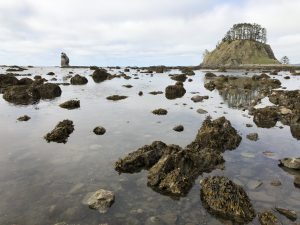
The rocky bench intertidal habitat at Ozette in Olympic National Park. The tide flats are broad, but rocky and wave-swept.
While soft sediment and shallow-sloped mud of estuaries and salt marshes offer the most protective environments for green crabs, this species can also survive the environmental conditions, like temperature and salinity, in a wider range of habitat types. At the earliest stages of invasion, green crabs are typically limited to their “core” protective habitats, but if populations become large enough, green crabs can persevere even on more open wave-swept beaches, at least those with shallow slopes and protective rocks. That means we can start to find them in new places in detectable numbers. In past years a few reports of green crabs had come from the northern portions of Washington’s Pacific coastline, including from Olympic National Park and open areas of Makah Bay. In 2024, Makah Fisheries conducted trapping near Cape Alava and the Ozette reservation, capturing more than a dozen green crabs across the open bench intertidal beaches. The total numbers and capture rates in these habitats are still somewhat lower than green crab density in soft sediment coastal estuaries like Willapa Bay, but these observations echo reports from Oregon, where green crabs are increasingly captured outside of their estuarine “core habitat.”
Green crabs were detected for the first time at the mouth of the Quileute River on the Quileute Reservation.
The large seasonal flows of meltwater from the Olympic Mountains makes many of the river mouths along the Pacific Coast of Washington inhospitable for green crabs. However, green crabs can make use of even short segments of the river where tides mix with freshwater at the mouth. In August, a trapping effort hosted by Quileute Natural Resources captured more than 30 green crabs over the course of a week. While the number is alarming for a first detection, it was noted that most of the crabs captured were either young of the year, or in poor condition. One possible explanation is that during relatively mild summer conditions, green crab larvae can settle into the river mouth, but very few make it through the winter, intact or at all! So far, this site seems to be a harsh, but survivable, habitat for green crabs, and more time will be needed to see whether the population changes.
The young of the year cohort was especially large and concentrated in late spring/early summer.
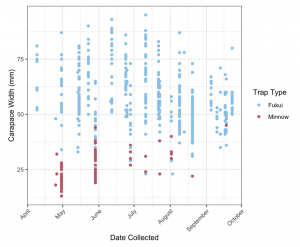
Size of green crabs captured by the date of capture and type of trap from the Crab Team monitoring network sites in 2024. Click to enlarge
A number of groups noticed a jump in the number of very small crabs in traps this year, and that timing was concentrated from late April through June. This is different from the timing that young of the year were most commonly trapped across Salish Sea geographies, which was in August and September. Additionally, at coastal trapping sites, the greatest numbers of young of the year crabs were captured at sites that were close to the mouths of estuaries, such as the north end of Willapa Bay, and sites near the mouth of Grays Harbor. One possible explanation for these differing patterns is that the two strong cohorts were released at different locations with different reproductive timing for adult crabs. The timing of these small crabs in coastal estuaries is consistent with early arrival from southern populations in Oregon or even California. En Niño conditions tend to favor higher northbound flow, moving larvae quickly up the coast.
Green crab increase was especially pronounced in the southern portion of Willapa Bay.
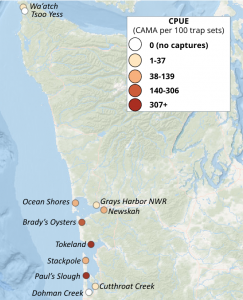
Map of 2024 green crab catch rates at Crab Team network monitoring sites. This does not show the extensive trapping activities that partners conducted outside of monitoring, but does highlight overall patterns of relative abundance of green crabs across this large region. Click to enlarge
One particularly concerning observation this year was that many of the sites with the largest increase in catch rates were in the southern portion of Willapa Bay. On average, sites trapped by US Fish and Wildlife Service in Willapa National Wildlife Refuge around Long Island, and the southern reaches of the estuary, experienced catch rates up to 10 times greater in 2024 compared to 2023. This was echoed in the catch rates from Cutthroat Creek, a site monitored as part of the Crab Team network. While overall green crab catch rates are still relatively low (compared to the northern portion of the bay), it is the speed and magnitude of an increase in this location that is most worrisome.
Despite being a single estuary, Willapa Bay is composed of two distinct regions divided roughly in half by what is known as “the fattening line.” Water below the fattening line has a higher residence time in the estuary, and there is greater ocean exchange of waters above the fattening line. This helped slow the spread of green crab down into Willapa, but may ultimately serve to enable very rapid population growth. Previous research highlighted that any green crab larvae released in the southern portion of the estuary are more likely to stay within Willapa Bay, instead of getting washed out into the Pacific Ocean. So, while to date the southern portion of the bay has historically had smaller numbers, or sites where green crabs were undetectable, this year’s findings could signal the onset of a rapid shift, not only in the southern portion, but baywide.
Collectively, these observations continue to point to an ongoing and, in fact, expanding invasion by green crabs. There are some heartening signs that the trapping efforts of those hard at work in the mud can knock back populations for a short time. This might appear as a decrease in the number of the largest crabs at a site nearing the end of the trapping season. Analogous to “fishing down a population,” this means that crabs aren’t surviving as well to grow to those large sizes – because they are being caught by trappers! Keeping up the pressure to further reduce the numbers of younger smaller crabs would be a next step toward controlling population numbers and impacts overall.
On the coast, green crab abundances are high enough to sustain catches even during the winter months. Trappers like the Shoalwater Bay Indian Tribe and others continue to work despite the chilly, windy, and wet days, taking advantage of breaks in the weather to get traps in the water and crabs out of it. Though the conditions are rough, we’re hopeful that these colder temperatures this winter will mean less survival for the early life stages of green crab, and make 2025 a year of lower crab abundances.
–Emily Grason
This information would not be available without the contributions of coastal trapping partners, including: Shoalwater Bay Indian Tribe, Pacific County Conservation District, Pacific County Invasive Species Management, Willapa Bay Grays Harbor Oyster Growers Association, Washington Department of Fish and Wildlife, US Fish and Wildlife Service (Willapa NWR, Grays Harbor NWR), Makah Fisheries, Quinault Indian Nation, Quileute Tribe, Grays Harbor Conservation District, Pacific Seafoods, Washington Department of Natural Resources, Coastal Interpretive Center, and numerous individual shellfish growers.
Header photo: Statewide trapping partners from the 2024 WSG Trappers’ Summit hosted by Crab Team at the Clearwater Casino in Suquamish. Staff from partners working with tribes, agencies, and shellfish growers convened in December, sharing observations and questions to help advance green crab management in Washington State.
FEB
2025